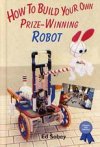Roboroach and Company Additional Information
You can learn more about Noah Cowan’s work on cockroach antenna and robots at www.jhu.edu/news_info/news/home05/mar05/antenna.html (Johns Hopkins University).
You can learn more about Frank Grasso’s robolobsters at www.brooklyn.cuny.edu/bc/spotlite/news/081803.htm (Brooklyn College) and ehp.niehs.nih.gov/members/2004/112-8/innovations.html (National Institutes of Health).
Information about other robotics research involving lobsters can be found at www.neurotechnology.neu.edu/ (Northeastern University) and www.spie.org/web/oer/september/sep00/cover1.html (International Society for Optical Engineering).
For other research on biologically inspired robots, see biorobots.cwru.edu/ (Case Western Reserve University), www.dcmilitary.com/army/pentagram/8_39/features/25612-1.html (Pentagram), www.cim.mcgill.ca/~arlweb/ (McGill University), and www.physorg.com/news1193.html(PhysOrg.com).
For information on a cockroach-driven robot, see www.conceptlab.com/control/ (Garnet Hertz).
If you’re interested in working with a six-legged, insect-like robot, take a look at Stiquito (www.stiquito.com/).
Sohn, Emily. 2005. Walktopus. Science News for Kids (Aug. 31). Available at http://www.sciencenewsforkids.org/2005/08/walktopus-2/.
______. 2005. A sense of danger. Science News for Kids (April 13). Available at http://www.sciencenewsforkids.org/2005/04/a-sense-of-danger-2/.
______. 2004. Inspired by nature. Science News for Kids (Nov. 3). Available at http://www.sciencenewsforkids.org/2004/10/inspired-by-nature-2/.
Books recommended by SearchIt!Science:
 |
Robots Among Us: The Challenges and Promises of Robotics— Christopher W. Baker
Published by Millbrook Press, 2002.
How do scientists program robots to complete tasks that you complete every day? In this book about the challenges of creating robots, learn about how scientists teach robots to sense, think, and act. Explore efforts to create machines to go places that are too dangerous or too difficult for humans. Find out about the remote-controlled robots that have been used to explore the insides of volcanoes and defuse bombs, as well as the potential for robots around the house. Discover the latest technology to create robots with artificial intelligence. |
 |
How To Build Your Own Prize-Winning Robot — Ed Sobey
Published by Enslow Publishers, 2002.
Can you design and build your own robot? Sure you can—and this practical book will show you how! (It’ll help if you have tools and materials such as servos, wheels, wire cutters, circuit boards, a computer, and a voltmeter.) The first chapter offers a general introduction to robots, and gives you instructions on how to build a motorized model car or boat. Electric motors are explained in the second chapter, which teaches you about selecting motors and voltage. Modifying servo motors, attaching wheels, selecting your robot platform, providing electrical power, and controlling your robot’s motion are discussed in the subsequent chapters. The final two chapters offer suggestions about how to make your robot do more through electronics, and how to apply your robot-building skills to science fairs and robot contests. |
Power Words
antenna 1. One of two long, thin body parts that are found on the heads of most insects and many other invertebrates, such as crabs and lobsters. Most antennae are used as feelers, but some are sensitive to heat or smell. 2. A metal device used to send or receive signals, such as radio signals, that are carried by electromagnetic waves. A satellite dish is a large type of antenna. Plural form: antennas or antennae.
cockroach A brown or black insect with a flat body and long antennae. Cockroaches prefer warm, humid climates and are mainly active at night.
robot A machine that can perform a variety of tasks either on command or by being programmed in advance. Robots can move about on their own and often have sensors so that they can react to things around them. Robots can be used in factories and in scientific research.
Copyright © 2002, 2003 Houghton-Mifflin Company. All rights reserved. Used with permission.
